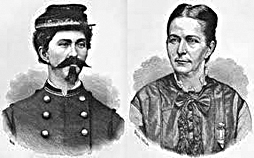Loreta became Lt. Buford with help
from disguise that included metal corset
By DR. JUDY PIERCE and DR. PAMELA JUKES
“Lt. Harry T. Buford, reporting for duty sir,” the soldier said to the captain. Little did the captain know that the young lieutenant was a woman disguised as a man.
Loreta Janeta Velazquez was born in Cuba in 1842 into a wealthy family. From the time she was a young child, Loreta was rebellious and dreamed of a life full of adventure.
Her childhood role model and heroine was Joan of Arc, the soldier, martyr and saint.
In 1849, Loreta was sent to live with her aunt in New Orleans to attend school. When she was 15 years old, she met and fell in love with a young army soldier, William Rouch. When Loreta learned that her father had arranged a marriage between her and a Spanish aristocrat, she and William eloped. For five years, Loreta was a soldier’s wife at several frontier outposts in Texas. During that time, she learned how to fire a pistol and use a sword.
When the Civil War began, the rebellious Velazquez was ready for adventure. She convinced William to resign from the United States Army and join the Confederacy. Loreta hatched a plan so that she could accompany her husband to his new post in Pensacola, Fla. She begged her husband to take her along to his new post, but William wouldn’t have any part of it. He told her to stay home.
After William left Florida, Loreta seized the opportunity to begin her transformation as a soldier. She cut her hair, purchased a black moustache and goatee and glued them to her face. Velazquez pushed her voice as low as she could, put on a manly swagger, and practiced spitting. Loreta hired a tailor to make two Confederate soldier uniforms and a metal corset that would hide her female physique and make her shoulders look more broad.
Being a wealthy woman, Loreta took her plan to the next level. She moved to Arkansas and raised a unit of 216 volunteers which she called the “Arkansas Grays.” Loreta, who was now calling herself Lt. Harry T. Buford, planned to take the company to Florida where her husband was stationed. However, before she could get to Florida, William was killed when a gun blew up in his hand. Devastated and angry because of her husband’s death, Loreta turned over the Graybacks to a friend and headed north.
Velazquez became an independent soldier and joined a Confederate regiment that was headed to Manassas Junction, Va. On July 18, 1861, a small band of soldiers in Loreta’s regiment were asked to stay behind and watch for Yankees crossing Bull Run Creek at Blackburn’s Ford. Loreta was elated that she was going to get to kill some Yankees.
When a group of Union soldiers were crossing the creek, the Confederate Soldiers, including Velazquez, opened fire. She was an idealistic soldier who was determined to make a stand on the battlefield and being at the center of the battle excited her. Unphased by the site of human slaughter, the battle to Loreta was glorious because the South won and it whetted her appetite for bigger battles.
Loreta got her wish a few days after the skirmish at Blackburn’s Ford. As spectators from Washington, D. C. watched from afar, the Union opened fire on the Confederate soldiers at the Battle of Manassas on July 21, 1861. The battle lasted all day as the two sides struggled for victory. Loreta enjoyed the excitement of the conflict so much that when her superior ordered a withdrawal, she flew into a rage. She calmed down when she realized that he was simply retreating to regroup for another charge.
In October 1861, the Union and South clashed again at the Battle of Ball’s Bluff in Virginia. Once again, Velazquez was in the center of the battle when she took command of a company because all of the officers had disappeared and were assumed dead. When the battle ended, however, the first lieutenant appeared and told her that he had been taken prisoner by the Yankees, but managed to escape. Loreta accused him of hiding during the battle.
Looking for more battlefield action, Velazquez traveled south through the southeastern part of Kentucky toward Ft. Donelson in Tennesssee. On Feb. 18, 1862, the Union and Confederate soldiers clashed in a bloody conflict. Loreta, who was very unhappy and angry that the Union won, was shot in the foot by a Union soldier and withdrew from the battlefield so she wouldn’t be discovered as a woman. Loreta fled to New Orleans to recover from her wound.
After a short recovery and seeking more adventure, Velazquez traveled back to Tennessee and took command of her old unit, the “Arkansas Grays.” While participating in her bloodiest battle, Loreta, for the first time, realized how terrible the human slaughter was. Dead and wounded soldiers were strewn across the field and she was exhausted and demoralized. While assisting with the burial of the dead, Loreta was struck in the left arm and shoulder with shrapnel from Union gunfire.
Fearing being unmasked as Lt. Buford, Loreta fled to New Orleans which was under threat of a Union attack and with citizens who were highly suspicious of everyone. Loreta was arrested twice, once as a Union spy and then as a woman posing as a man. The spy charges were dropped and Loreta ultimately confessed that she was a woman. She was fined $10 and spent 10 days in jail.
After a year as Lt. Buford, Loreta began to think of a new masquerade. As soon as she was able, she retired the uniform and exchanged it for a dress and became a spy for the Confederate Secret Service. Loreta traveled north and made many friends in important positions who could provide information such as naval operations, troop movements and munitions in the Union Army. She was so well liked and respected that Allan Pinkerton hired her as a Northern spy for the south. Velazquez accepted and throughout the rest of the Civil War, she served as a double agent. Loreta was never discovered as a spy.
When the Civil War ended, Loreta and her brother, who was a Confederate soldier, traveled to Europe. It was during this time that she wrote her memoirs. The book, The Woman in Battle: A Narrative of the Exploits, Adventures, and Travels of Madame Loreta Janeta Velazquez, Otherwise Known as Lieutenant Harry T. Buford, Confederate States Army was published in 1877. The book was highly criticized by Confederate Gen. Jubal Early who said that it was utter nonsense and that Lt. Harry T. Buford never existed in the Confederate Army. Recent documents, however, indicate that there was a cross dresser named Lt. Harry T. Buford. Loreta later married her fourth husband who owned a mining business in Nevada. It is believed by some historians that she remained in Nevada until her death in 1897.
|














